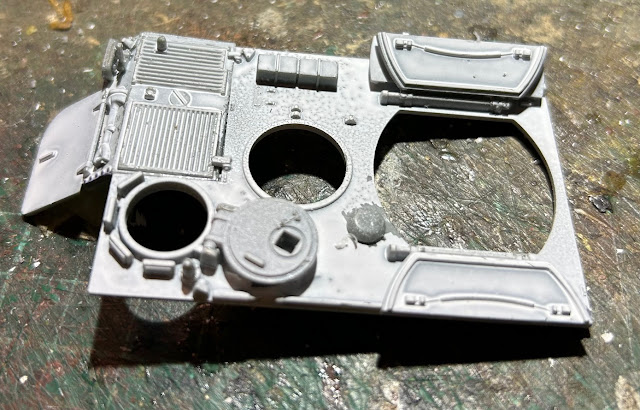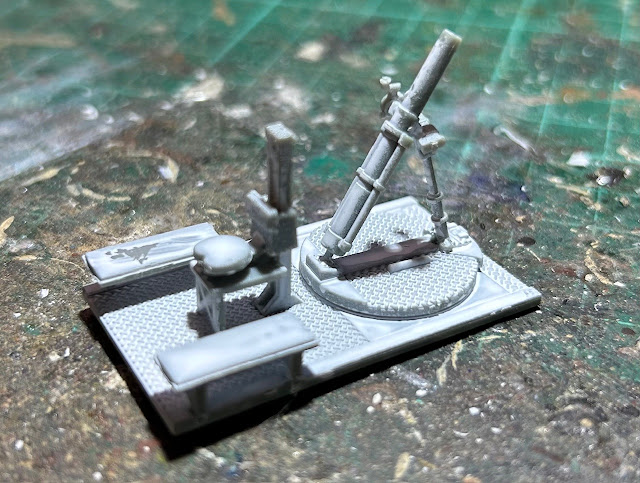I’m now a
little obsessed with building AFV models with interior details! After the
success of my Rubicon Tiger II, I then built my Fujimi 1/76 Jagdtiger and have
bought myself a Hobby Boss 1/48 T34/85 and an old Bandai 1/48 M4A3 Sherman
ready to build!
 |
| Rough sketch of how I planned to display the model |
As it
looked to be the most interesting (and came with a full crew) I chose the M106A1
4.2” Mortar Carrier to build and happily parted with my £20 at Firestorm Games.
On opening the box, you are faced with four well packed sprues (each sealed in their own bag), a very busy decal sheet (the same for each M113 variant) and a clearly printed assembly instruction sheet.
My initial observations are that it is very
clearly moulded in ABS plastic and the sprues contain some parts that you will
not need as they are intended for other M113 variants. One big missing is the
lack of paint schemes and information where the decals are to be placed. I’ve
had to do a lot of researching to identify where I think they are to go, which
whilst interesting has been time I could have been assembling! Some of the best
photographic references can be found here - https://www.flickr.com/photos/zippo132/with/39703953880
The model
can be built closed up, with all hatches open, with crew figures or without and
there’s even a spare 4.2” Mortar with shell boxes that can be built to display
separately.
I’ve
decided to build it with the crew outside manning this mortar and just the
vehicle crew in the actual vehicle. I’m planning to leave the hull top separate
so you can see all the engine, stowage etc. inside. I will design and print a 3D
display stand so these can all be shown together. I will make a few cuts to the
hull roof/front part so that the engine can be better seen.
On starting
the build, it became apparent that there are a lot of extra sprue bits on the
parts that all have to be removed, and the residue cleaned up.
I started by assembling the figures. Now, at this point I made a discovery!! I have always built Rubicon kits with Revel Contacta cement (the one with the syringe applicator) and never thought anymore about it. I also use AK liquid cement on models but knew that this didn’t work with Rubicon’s plastic. Whilst handling the assembled figures the following day, the driver’s arms fell off and I noticed that the glue hadn’t welded the parts, it had just set and held the parts on in that way. A quick Google taught me that you need a special glue for ABS plastics!! The consensus seemed to be either Plastic Magic or Tamiya Extra Thin cements were the best, so I had to make a quick trip to Cardiff to get some of the quick setting version of the Tamiya Extra Thin. This works very well, just putting the parts together dry and then a quick wipe of cement from the attached brush and the job is done. Just shows you never stop learning in this hobby!
The figures and assembled mortar were attached to scrap sprue to help with handling and given a coat of white primer prior to painting.
Whilst they dried, I tackled the running gear and tracks. The instructions suggest assembling them on the hull sides without glue in the wheels in place so they can be removed when dry, to make it easier to paint. This seems like a good idea so that’s what I did. I had to take care to follow the instructions closely as the tracks/wheels etc. are “handed”. When you assemble to two roadwheel halves, there is a small hole in the rim which must face downwards to accept the pins from the lower track length. The direction of track is crucial to get right, but the instructions are very clear and helpful. I left them to set overnight and the next day carefully removed the completed assemblies from the hull sides.
Next the engine and transmission were assembled – just three parts but it gives a good impression of the powerplant at this scale. The lower hull assembly comes next and all parts slot together extremely precisely. Dropping the engine assembly into the hull, the exhaust silencer rests on a moulded projection on the wing. The two partition walls can then be added before finally placing the driver’s seat assembly.
At this
point I modified the hull front piece to separate the radiator covers which
will be attached to the hull roof for display, leaving the engine on view.
Front hull cut to allow the engine to be seen later
Driver’s
steering tillers are provided, but with the ¾ driver figure installed these
will not fit. He is moulded with the steering handles in his hands and for what
you will be able to see with the hull front in place, will pass muster.
When doing
some research online, it became apparent that there would be a large radiator
and cooling fan assembly attached to the undersides of the radiator covers and
these are not represented in the kit. For completeness (as you’ll just about
see them when the model is displayed) I drew up and 3D printed a very
simplistic assembly which I attached to the underside of the radiator covers.
The 3D printed "Radiator Assembly" installed in the underside of the hull top
With this
all done, I could carry on assembling the hull sides and floor etc. These came
with simplified, but adequate interior detail, that just needed a little
enhancement.
 |
| Note the removed front quarter from the hull front was attached to the hull side to maintain the fit of parts |
One of the mortar round storage racks (with the cardboard tubes represented vertically) was beefed up with some plastic rod discs cut and attached to the top to represent the ends of the tubes. There’s also a rifle rack you could populate, however I didn’t have any scale M16’s so left that alone. Other details include the radio set, vehicle instruments and fire extinguisher.
 |
| Note the small plastic discs to represent the tops of the Mortar Round tubes |
Once the hull walls were assembled, they were attached to the hull base. Next, I assembled the roof section with it’s hatches folded open. The details like lifting hooks etc. were also added and the multi-part rear hatch completed too. The last assembly was the two mortars (interior set-up & exterior set-up) and the commander’s cupola with .50” MG.
I now had
the vehicle build completed in 7 sub-assemblies and could think about painting.
The Inner hull was sprayed Vallejo Air 71.009 – Duck Egg Green. This is a great match for vehicles I’ve seen pictured on the internet. Once dry, this was weathered with Army Painter Strong Tone wash and seat, mortar round, radio etc. details picked out. The engine compartment received a bit more in the way of “Dirt” weathering as befits a well-used diesel!
I mentioned the lack of info on decal positions, the first example being that there are some really excellent internal warning signage included that you need to find out the location for. The internet came to the rescue here and they were positioned to the right of the driver’s seat and on the bulkhead behind the engine.
Come back for part two to see the model reach completion!


















No comments:
Post a Comment